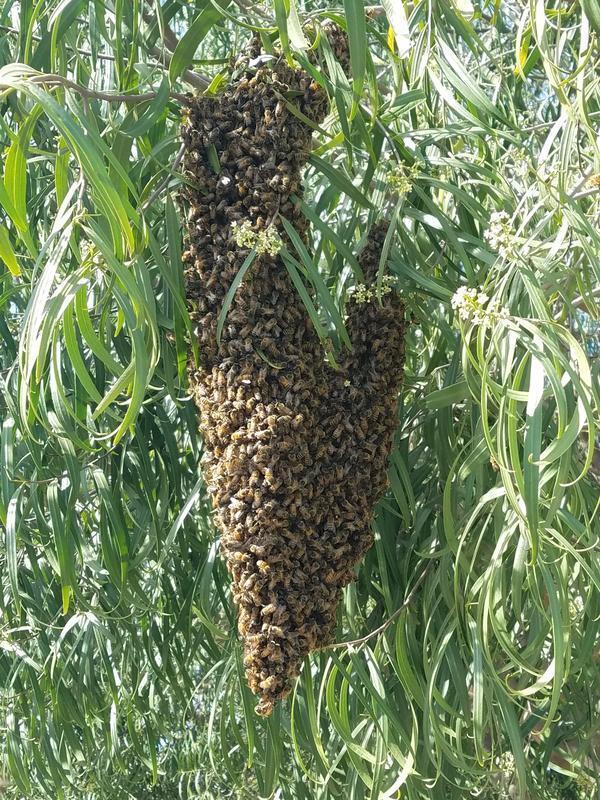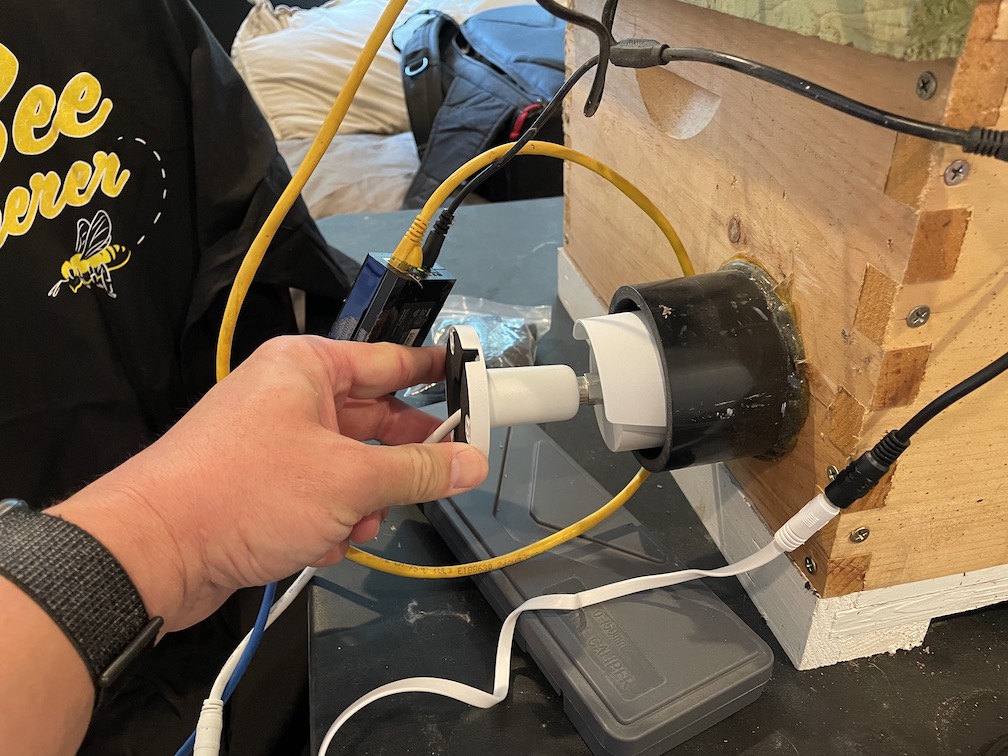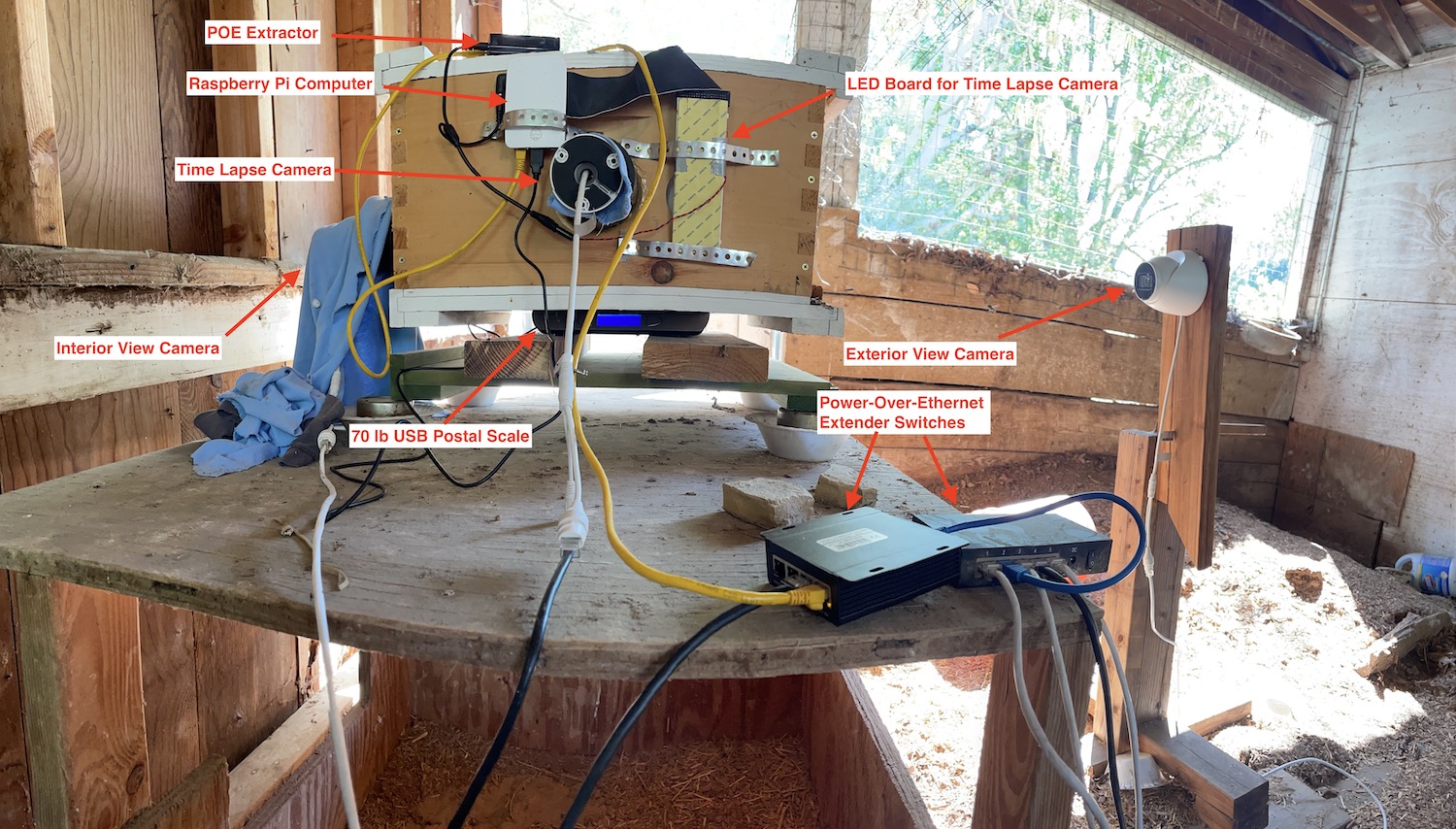Expand your browser to at least 1800 pixels wide to see them side-by-side. Or send me some HTML or CSS that will fix it for me ;-)
Click Play on each video to watch them side-by-side, and synced, or click the YouTube logo to open each stream in YouTube. If the streams are offline, send me a message, and I'll get them restarted.
If you want to watch them in separate windows (e.g. you can full-screen them or comment), click here:These cameras are looking at and into a "swarm trap," or "bait hive" in my unused chicken coop, where I catch at least 1 swarm of feral bees every year. Right now (02/24/21) I'm waiting for a swarm to move in, as they've done every year for the past several:
The inside camera is behind the box, looking towards the outside camera. In fact at night you can see the IR illumination from the front camera from the inside of the box, through the entrance gap at the bottom.
Once the "scouts" have discovered and evaluated this box, which I've baited with some drawn honeycomb and lemongrass oil (Cymbopogon flexuosus), they will return the mother hive and tell everyone they've found the perfect spot, and then the 10,000 - 20,000 bees and their queen will arrive in a giant buzzing cloud, and move in.
On the afternoon of 2/22/21 I had a very high amount of scout activity, so I am expecting a move-in event any day now, though in the past I've had as much as 2 weeks of healthy scout activity before a move-in.
I also have my "main" BeeCam here, rotating amongst my established hives.
If you see a ball of bees hanging onto a tree branch, rear-view mirror, mailbox, etc., that is a "reproductive swarm," and the result of a nearby colony of bees having a good season.

When an established colony has more than enough bees and honey to ensure its survival through the winter, the workers will raise one or more "replacement" queens. When those new queens are just about to emerge, the old queen will leave with ~50% of the bees and search for a new place to live. This is the way the colony, as a "super organism," reproduces.
The bees will fill their honey stomachs and "swarm" out from the old colony in a cloud of 10,000 - 20,000 bees, and then settle on a branch, etc., as described above. They will wait here, with the queen, for 2-3 days until their scouts find a new cavity to inhabit, or else they will run out of stored food and die. 😢
The site selection process is documented in extraordinary detail in Honeybee Democracy, by Professor Thomas Seeley of Cornell University. It's a fascinating read, although a follow-up study by Seeley and Kirk Visscher provides additional detail, including evidence that scouts begin evaluating potential nest sites before the swarm leaves the mother hive.
They are typically not aggressive when hanging in a swarm, because they are not defending anything, and their abdomens are so distended from the honey that it's actually difficult for them to sting. Here's a video of people passing their hands right through a hanging swarm without getting stung.
Once the scouts have found a suitable new home, they will alert the swarm, and it will fly away in a second giant cloud, move into the new cavity, and start building comb so that the queen can lay eggs and begin a new colony. This box is an attempt to provide them with a perfect home.
It's like a wandering, homeless tribe finding a free Holiday Inn with fully stocked minibars.
The outside camera is an Amcrest IP5M-T1179EW-28MM "eyeball" or "turret" camera, while the inside camera is an Amcrest IP5M-B1186EW-28MM "bullet" style camera. I chose the bullet for the inside view so that it would fit inside a 3" ABS baffle:

The baffle is attached to the side of the box with clear silicone caulking, and the camera is looking through a square piece of glass.

The audio for the interior camera is from the YouTube royalty-free library, as the interior camera doesn't have a mic, despite being more expensive.
I'm streaming the video via an old $38 Raspberry Pi 3B ($30 at the time), with each stream running on a separate instance of ffmpeg. Although ffmpeg is the "Swiss Army Knife" of video transcoding and manipulation, I'm using it only as a "relay station," to pull an RTSP stream from the camera and push it to the YouTube streaming server via RTMP. As such, it's not doing any transcoding at all. At most it's repackaging the mp4 video packets into flv format (Flash Video, which YouTube retains as its preferred input format for Stream Now video), and, in case of the interior camera, it's also remuxing audio into the stream. Neither operation is especially CPU intensive, and each instance of ffmpeg (once per stream) consumes only 12% - 20% of the CPU on my little RPi computer. I actually have 4 streams running on my $30 widget, and it's not even close to being CPU bound.
The ffmpeg script is of the general form:
#!/bin/bash
cd /usr/local/bin/
while true
do
./ffmpeg -thread_queue_size 1024 -rtsp_transport tcp -i "rtsp://anonymous:password1@192.168.1.13:554/cam/realmonitor?channel=1&subtype=0" -vcodec copy -acodec copy -t 01:00:00 -f flv "rtmp://a.rtmp.youtube.com/live2/insert-your-youtube-streaming-key"
echo Stream1Complete
sleep 5s
done
The actual command varies slightly by camera, depending on what the RTSP URL is for that brand, and whether or not it has an audio stream from a built-in mic. If there's no audio stream I can either use "-map 0:v -map 1:a" to grab the audio from another camera (as I'm doing for the interior view, here), or I can use something like "-f concat -safe 0 -i playlist.txt" to use a playlist of royalty-free MP3s, as I do with the main BeeCam.
I run each stream as a Raspbian service, along with a watchdog timer that is supposed to kill and restart the service if the YouTube stream goes down for more than 5 minutes. The watchdog script isn't working right now, because YouTube changed something in their data API and/or quotas back in 2020, so right now I'm doing a lot of manual fiddling with the service, so the streams go offline more often than I'd like.
Ideally I'd like to put the two videos side-by-side before sending them to YT, which ffmpeg is capable of doing, but my experimentation with that results in an order of magnitude more CPU requirement than the "relay" streaming uses, so I can't use the RPi for that. Even a modest quad-core desktop CPU struggles with this. Unless I'm doing it wrong. If you know ffmpeg well, I'd love some help with this. I have 3 different dual-camera setups that I'd like to stream as side-by-side videos, but I don't want to spend $1,000 for a workstation-class computer to make it work.
There's yet another IP5M-B1186EW-28MM camera and Raspberry Pi on the side of the box, in an attempt to capture several months of comb-building for a time-lapse video. The GPIO pins on the Pi are cabled to a breadboard populated with a bank of white LEDs. The Pi turns them on for a few seconds every 10 minutes and grabs a JPG from the camera via the curl utility. The Pi and the LED board are powered by a switchable 5 V POE Extractor, a 2.1 mm splitter cable, and a 2.1 mm to micro-USB adapter. Then the 5 V goes into the breakout board where it's switched through a TIP122 transistor, controlled from the GPIO pin, and limited by a 430 Ohm series resistor (included with the LEDs). I'll draw up a schematic for this, some day.
I also want to see the total weight of the bees that move in, so I have a scale underneath the hive box. It's a 70-lb-capacity postal scale from stamps.com (Normally $99, but I got this for $50 as a promotional offer when signing up for a new stamps.com account).
It's connected to, and powered by, the Pi via USB, using the open-source usbscale driver and application, and I have a simple script to log the weight every 10 minutes. When the swarm moves in, I'll know how much weight they added, and then I can guesstimate how many bees there are. For reference, a 3 lb. "package" of bees is typically estimated at 10,000 bees, though I have never counted them individually. A package also costs $150 - $200, so a swarm is a valuable commodity!
Then, as the swarm gets established, collects food, and raises brood, I'll be able to track the weight gain of the hive over a period of a few weeks, before I move it to my main apiary, reset the trap, and start over.
Everything in the chicken coop is powered by a POE-powered-POE switch, which in turn is powered by a POE+ switch in my tack room, 70' away, connected by a long run of Cat5e cable buried in PVC conduit. Some day I'll run some proper AC into the chicken coop, and then everything will get a lot simpler. Or maybe I'll just add a ton more stuff 🤣
I welcome any and all feedback on any ways to improve this system or this page, including:
I'm Steven Kan, and I call my house Painted Peacock Manor. You can find or reach me via: